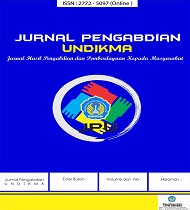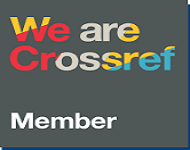Blended Learning Model in Technical Competence Training for Supervisors in the City of Bandung
DOI:
https://doi.org/10.33394/jk.v8i3.5513Keywords:
Blended Learning, Technical Competence, Training, Supervisor, Nonformal Education.Abstract
This research aims to describe the blended learning model in technical competency training for supervisory functional positions in the city of Bandung. In this research apply analytical descriptive method and quantitative approach by using documentary study. The data collection instrument used was a questionnaire with 60 surveyors in Bandung as respondents. Data analysis techniques were data collection, presentation and conclusion. In the application of this model, training in the professional ability of the supervisory function of the city of Bandung was carried out which is expected to increase the level of quality of the inspector in practice. Things that need to be prepared before carrying out training with the Blended Learning method include preparing facilitators who understand information and communication technology, providing learning management systems (LMS), providing internet devices, digital libraries, and facilitating understanding by changing delivery materials. In organizing the training, the organizers must pay attention to matters relating to communication, logistics, operators, participants, infrastructure, evaluation and monitoring of other training materials. It is important to evaluate and monitor the training process to uncover various gaps, weaknesses and strengths, both in its implementation and in the process. The results of this training assessment indicated that there was an increase in differences in knowledge aspects between before and after the Blended Learning model training in technical skills training for supervisory functional positions in the city of Bandung.
References
Alajääski, J., & Suomala, J. (2001). Another perspective on assessing the significance of information technology in education. Computers in the Schools, 18(2–3), 111–125.
Anyanwu, EU, & Ossai-Onah, OV (2011). Utilization of ICT facilities by students in Nigerian universities from ICT staff perspective: A study of two institutions. The Information Technologist: International Journal of Information andCommunication Technology, 8(2), 139–145.
Baker, VL (2015). People strategy in human resources: Lessons for mentoring in higher education. Mentoring & Tutoring: Partnership in Learning, 23(1), 6–18.
Bastas, M., & Altinay, Z. (2019). Employment for Disability: Human Resources Management in Higher Education for Quality. International Journal of Disability, Development and Education, 66(6), 610–615.
Cholifah, I., Ansori, A., & Mulyono, D. (2020). Profile of Utilization of Technology and Information Literacy (Tik) by Cimahi City Supervisors. Comm-Edu (Community Education Journal), 3(2), 174. https://doi.org/10.22460/comm-edu.v3i2.3822
Damayanti, E. (2018). Supervision and Monitoring of the Implementation of the PAUD Program in Kober Al-Hidayah. 3(1), 1–4.
Eddie Suharto. (2005). Building Community Empowering the community. Aditama Refika.
ER, ND, & Hiryanto. (2013). Model of Professionalism Development for Out-of-school Education Supervisors. Educational Science Research Urnal, 6(1), 10.
Fitria, L. (2020). Professional Development Model to Improve Supervisor Competence. Journal Of Early Childhood Islamic Education, 3(2), 171–181.
Gannaway, D., Hinton, T., Berry, B., & Moore, K. (2013). Cultivating change: disseminating innovation in higher education teaching and learning. Innovations in Education and Teaching International, 50(4), 410–421.
Geng, Y., & Zhao, N. (2020). Measurement of sustainable higher education development: Evidence from China. Plos One, 15(6), e0233747.
Harjanto, E. (2006). Supervisor's Role and Competency Standards. Scientific Journal of VISION PTK-PNF, 1(2), 34–39.
Hasibuan, S. (2004). Management. PT. Earth Literature.
Igual, R., Plaza, I., Ibañez, F., Medrano, C., & Arcega, F. (2014). Quality and innovation. Web-based code of good teaching practice. Proceedings of the 2014 Workshop on Interaction Design in Educational Environments, 89–96.
Johnson, DL, & Maddux, CD (2007). Introduction: Effectiveness of information technology in education. Computers in the Schools, 24(3–4), 1–6.
Junaidi, F. (2020). Strategies for Supervising Early Childhood Education Educators through Responsive Guidance at Dewi Sartika Early Childhood Education, Muara Bangkahulu District. Al Fitrah Journal Of Early Childhood Islamic Education, 4(1), 39–50.
Laha, MB (2020). Performance of Equality and Literacy Inspectors in Gorontalo Regency. Aksara: PNF Science Journal, 6(1), 80. https://doi.org/10.37905/aksara.6.1.80-88.2020
Maddux, CD, & Johnson, DL (2006). Type II applications of information technology in education: The next revolution. Computers in the Schools, 23(1–2), 1–5.
Marcellyna, N. (2020). EFFECTIVENESS OF ONLINE TECHNOLOGY-BASED TRAINING. 3(2), 50–60.
Muhammad, AS (2019). Supervising Supervision and Teacher Work Motivation in Improving Teaching Performance for Early Childhood Teachers. Journal of Educational Administration, 26(2), 225–237. https://doi.org/10.17509/jap.v26i2.21305
Mustaro, TIA (2019). Supervising Guidance Strategy in Guiding Early Childhood Educators through Responsive Guidance Services. Obor Penmas Journal: Education Outside School, 2(1), 78. https://doi.org/10.32832/oborpenmas.v2i1.2252
Ogunsola, LA, & Aboyade, WA (2005). Information and communication technology in Nigeria: Revolution or evolution. Journal of Social Sciences, 11(1), 7–14.
Olim, A. (2004). The China Paper.http://ayiolim.wordpress.com
Peterson, M. (1998). The virtual learning environment: The design of a website for language learning. Computer Assisted Language Learning, 11(4), 349–361.
Rizka, M., & Hardiansyah, R. (2016). Strategi pengembangan inovasi program pendidikan nonformal sebagai best practices bagi pusat kegiatan belajar masyarakat. JPPM (Jurnal Pendidikan dan Pemberdayaan Masyarakat), 3(2), 187-196. doi:https://doi.org/10.21831/jppm.v3i2.10745
Rizka, M. A., & Tamba, W. (2019). Pelatihan Evaluasi Program Pendidikan Nonformal Bagi Pengelola Pusat Kegiatan Belajar Masyarakat (PKBM) di Kecamatan Gunungsari Kabupaten Lombok Barat. Paradharma (Jurnal Aplikasi IPTEK), 2(1).
Rosenberg, Marc, J. (2001). E-Learning: Strategies For Delivering Knowledge In The Digital Age. McGraw-Hill Companies.
Simamora, H. (2004). Human Resource Management. Third Edition. STIE YKPN.
Suminar, T. (2014). Performance Evaluation of Paudni Supervisors in Central Java Province and Yogyakarta Special Region. Journal of Out-of-school Education, 43(1), 15–24.
Umar, A. (2019). Evaluation of Career Development Policy Implementation for Supervisors. Journal of Wahana Karay Scientific_Postgraduate (S2) PAI Unsika, 3(1), 252–257.
Zhao, J. (2008). An Examination of Students Perception of Blended E-Learning in Chinese Higher Education.www.springerlink.com/index/r823125035647432.pdf
Downloads
Published
How to Cite
Issue
Section
Citation Check
License
License and Publishing Agreement
In submitting the manuscript to the journal, the authors certify that:
- They are authorized by their co-authors to enter into these arrangements.
- The work described has not been formally published before, except in the form of an abstract or as part of a published lecture, review, thesis, or overlay journal.
- That it is not under consideration for publication elsewhere,
- That its publication has been approved by all the author(s) and by the responsible authorities tacitly or explicitly of the institutes where the work has been carried out.
- They secure the right to reproduce any material that has already been published or copyrighted elsewhere.
- They agree to the following license and publishing agreement.
Copyright
Authors who publish with JK agree to the following terms:
- Authors retain copyright and grant the journal right of first publication with the work simultaneously licensed under a Creative Commons Attribution License (CC BY-SA 4.0) that allows others to share the work with an acknowledgment of the work's authorship and initial publication in this journal.
- Authors are able to enter into separate, additional contractual arrangements for the non-exclusive distribution of the journal's published version of the work (e.g., post it to an institutional repository or publish it in a book), with an acknowledgment of its initial publication in this journal.
- Authors are permitted and encouraged to post their work online (e.g., in institutional repositories or on their website) prior to and during the submission process, as it can lead to productive exchanges, as well as earlier and greater citation of published work.
Licensing for Data Publication
-
Open Data Commons Attribution License, http://www.opendatacommons.org/licenses/by/1.0/ (default)

This work is licensed under a Creative Commons Attribution-ShareAlike 4.0 International License.







